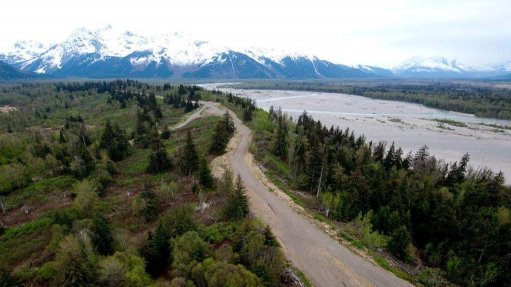
Tulsequah Chief
Photo by: Chieftain Metals
TORONTO (miningweekly.com) – Project developer Chieftain Metals on Monday said an Aquatic Ecological Risk Assessment report carried out by accredited third-party consultants had concluded that the fish resource downstream from the $450-million Tulsequah Chief polymetallic project, in British Columbia, is at a healthy level and the 60 years of historic discharge posed a low risk to fish.
At the request of the British Columbia Ministry of the Environment, British Columbia-based independent scientists from Palmer Environmental Consulting Group, Core6 Environmental and Triton Environmental Consultants evaluated the water quality at four sites on the Tulsequah river near the confluence of the Taku river, where the mine is located.
The group studied the discharge impact on various types of fish, including coho salmon, sockeye salmon, Dolly Varden and bull trout and chinook salmon. Fish tissue studies showed the fish were unaffected and that there was no discernible impact from the historic discharge resulting from previous mining operations.
The report stated that, overall the potential risk to aquatic receptors as a result of mine discharge is considered low. The report also stated the discharge did not affect the Taku river.
Chieftain asserted that it had followed all the necessary steps, procedures and consultation requirements and had obtained permits for the project in line with the land use plan and shared decision-making agreement between the Taku River Tlingit First Nation (TRTFN) and British Columbia entered into in July 2011.
The company said it was looking forward to negotiating an impact benefits agreement with the TRTFN in good faith, including monetary compensation, local business opportunities and employment for the First Nations in the area.
“We have the necessary permits to begin mine construction, including the environmental assessment certificate received in 2012. The land use plan allows for the mine and road construction.
“In December 2013, we released a third-party water quality assessment to the British Columbia Ministry of Environment confirming the fish are unaffected by the mine discharge. Chieftain has worked tirelessly to advance the project and remains committed to working with the TRTFN and all other stakeholders in advancing the Tulsequah Chief project,” Chieftain president and CEO Victor Wyprysky said.
The Tulsequah Chief project, deemed to be one of the world's lowest-cost zinc mines, currently held a National Instrument 43-101-compliant probable reserve of 6.45-million tonnes grading 1.13% copper, 1.04% lead, 5.59% zinc, 2.3 g/t gold and 81.39 g/t silver.
In the indicated resource category, the project currently held an estimated 6.77-million tonnes grading 1.19% copper, 1.1% lead, 5.89% zinc, 2.4 g/t gold and 85 g/t of silver.